
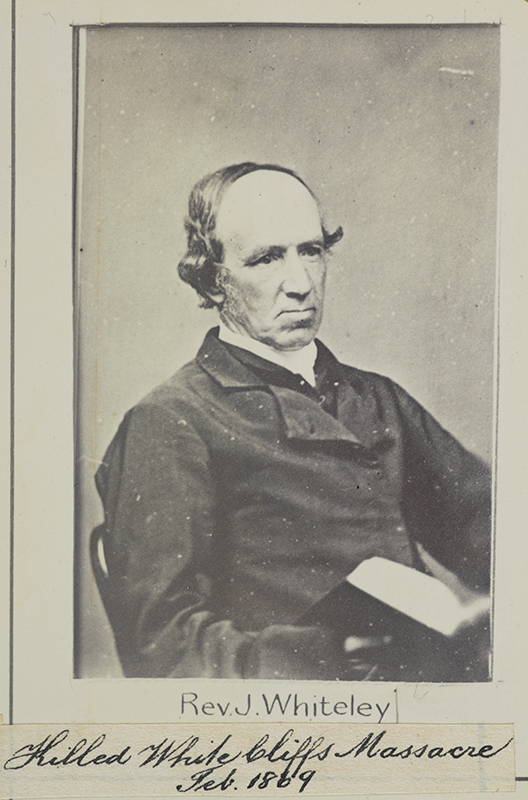
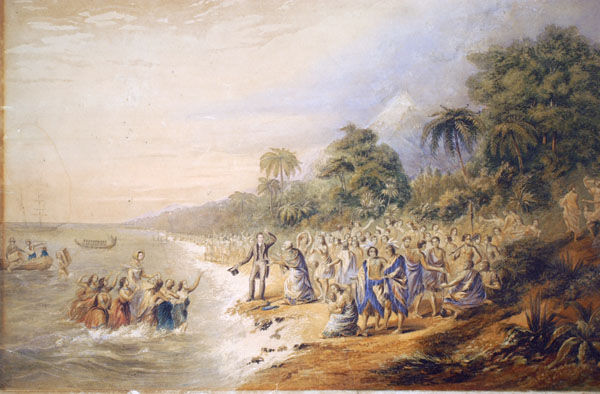
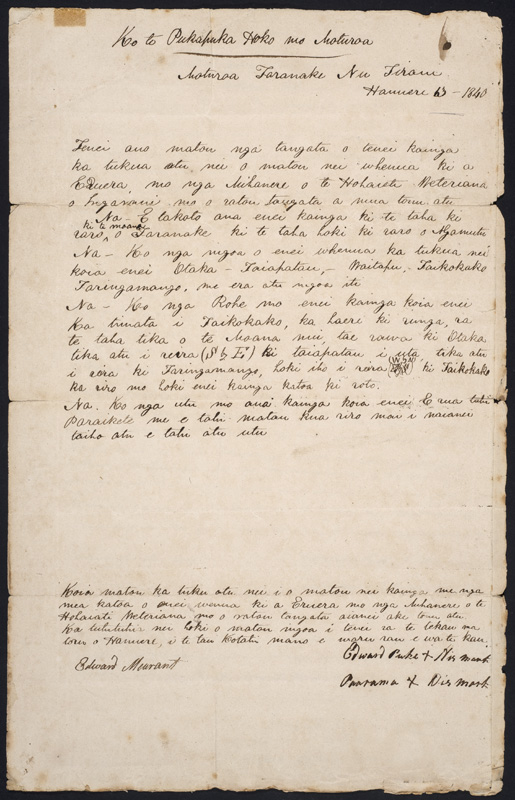
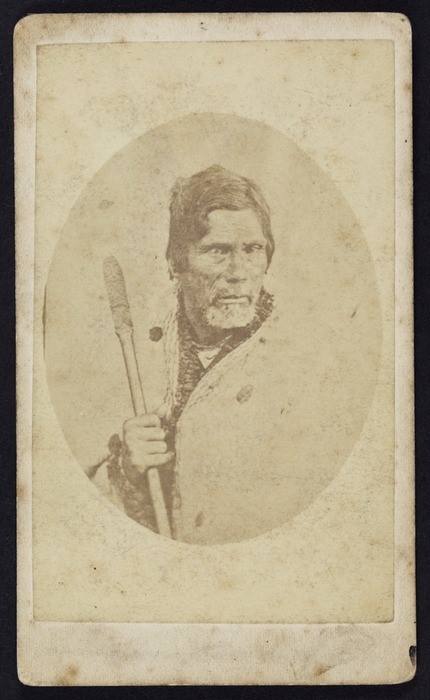
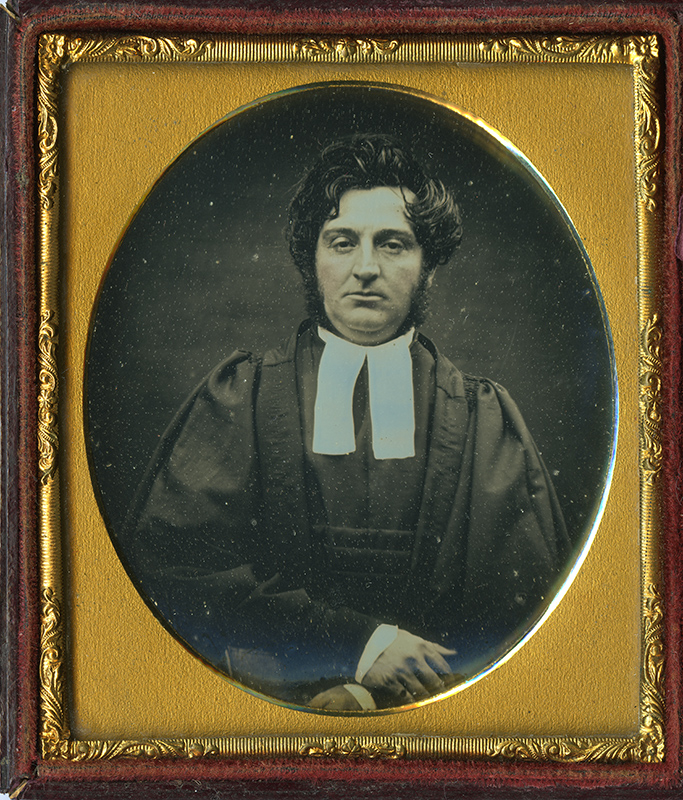
In 1839, two Christian teachers, Wiremu Nēra Te Awa-i-taia and Hohaia were posted to Ngāmotu by the Welseyan Mission at Kāwhia. In January 1941, Charles Creed and his wife arrived in New Plymouth and by September a chapel was operating.
After the Creeds left in 1843, Henry Turton and his wife Susanna carried on the good work. They planned a mission school for Māori pupils, with an agricultural bent. Turton felt it would be impossible to provide a standard European education to local Māori children, unless they were separated from their parents and given food and clothing at the mission's expense. He decided to implement a new approach to Māori education by drawing energy into farming as well as bookwork. He also planned to teach English. It all depended on funding.
In 1845, there was not money enough in the Mission's coffers for even one salaried teacher, let alone a school building and accommodation. Though Turton applied to the British and Foreign School Society for both, his request was declined. He looked to Governor George Grey for a special grant and was turned down again, though Grey sent a personal donation of £5 in support.
Eventually Turton opened a school with a single teacher to teach both adults and children. It was held at a pā next to the mission and ran morning and nights so that those who worked in the fields could attend.
The teacher's salary was paid from Turton's own pocket, but he knew the sustenance of the school depended on funding. He wrote to the Committee in London asking for a grant and reimbursement of money spent. Money was not forthcoming and school was suspended during 1847 due to falling rolls, as a result of the unsettled state of Taranaki over land sales.
Later that year, under the direction of Governor Grey, the Government gave £200 towards the cost of new buildings and the construction of a new classroom, teacher's room, dining room and dormitory catering for 40 boys.
In late 1848 or early 1849, the Grey Institute opened for business, with local settler Mr B. Berry hired as teacher and his salary paid by the Government through the Wesleyan Missionary Society.
An unnamed Māori teacher – thought to be Wiremu Kīngi Te Rangitāke – was taken on to oversee the scholastic and agricultural work. Later Thomas Skinner, a young missionary previously based at Taupō, was sent down to be schoolmaster.
Government funding continued as grants and Governor Grey's interest in the school became a great asset. Visiting the school for the first time in 1850 he became a close to Turton. The missionary had recently lost his wife and had begun to isolate himself from his work and workers and it is said Grey's support helped him back into his educator's role.
Over time the school was enlarged, with a piece of property at Ōmata acquired for farm use.
But it would be Turton's agricultural passion that saw him lose his reputation. As Sally MacLean writes in A history of the Ngamotu Mission and the Grey Trust Institute: "At the Ngamotu Mission station, working on the land had been part of attending the school since well before the advent of the official industrial school policy.
The lack of funding for a school had led Turton to the idea of farming a portion of the mission land for the school's support. With the establishment of the Grey Institute, the development of the mission land went ahead at a great pace; during the first eight months over 12 hectares (30 acres) were cleared and ploughed.
The Grey Institution farm diary kept by Thomas Skinner for the first six months of 1850 is still in existence. It details the daily work carried out by the pupils and hired hands.
Although the diary covers a busy period during which the farm was still being cleared and the crops harvested, it is difficult to escape the conclusion that during this time the primary aim of the school was not the development of the pupils but the development of the farm.
Labourers were employed to mow and stook the wheat, while the pupils, unpaid, helped with harvesting; they also cleared, fenced and ploughed additional land. Some spent days on end clearing scrub. For some of the students, this was not a satisfactory situation.
In May 1850 teacher Wiremu Kingi appears to have led a rebellion against the work regime. It was shortly after this that the students' hours of work on the farm were reduced."
In 1854, a girls' school was added, capable of housing 25 girls. Turton's second wife, Mary Ellen Walsall, took control. But the next five years proved very difficult for the Grey Institution. Taranaki witnessed bitter fighting as Māori disputed land sales at Puketapu and war quickly ensued between European and Māori.
By 1856, the township of New Plymouth was in turmoil. Concerned citizens, increasingly scandalised over Turton's farming operations ('more a farmer than a minister') welcomed John Whiteley to the mission. Turton offered to resign but Whiteley talked him out of it and he would remain in the mission house for another year. But the mission authorities told Whiteley he must sell off all farm stock and implements and re-let the land, keeping just 8 hectares (20 acres) back in the hope the Grey Institution would reopen.
From 1857, the mission farm was leased to Jack Hawkins for five years, with the greater part of mission land split from the Ngāmotu Mission Station and the institution, with the money ending up in a consolidated Auckland District Mission Properties Trust.
Now Whiteley was ordered to move into the mission house, so the mission did not look deserted, and a missionary on the site meant the school could reopen as soon as the trouble ended.
Governor Grey, upset at the shutting of the school and subsequent attempts to rent the land, pointed out the Government had spent large amounts of cash on the school and no more would be forthcoming, unless the deeds were handed over and a Crown grant put in place.
Though Turton and Whiteley were very distressed by this, Māori must have felt worse – closing the church and leasing the land was an obvious betrayal and breach of faith in the wake of an original proposal.
By 1857, a tenuous peace had fallen over Taranaki and the Grey Institution opened its doors once more though the girls' school stayed closed. Rolls gradually increased from four students to 34, but feeding pupils presented difficulties as leasing off land meant no farming and there was still a dearth of funds.
The Grey Institution struggled on, but when the Puketapu Feud flared up again the following year times got really tough. Turton found himself in the middle of another scandal when charges of 'smoking, snuff taking and the free use of intoxicating drinks' were laid against him. He left New Plymouth and sailed first for Kāwhia and then for England.
When the Taranaki Wars began in 1860, martial law was declared. Because the majority of pupils at the school belonged to hapū fighting the Government, those who sided with the Government withdrew their children.
By 1863, only a handful of boys remained and once again the doors closed. Six years later, the Grey Institute became a day school for pupils of both sexes.
When the Native Schools Act of 1867 changed Government funding for Māori education at mission schools by giving funding to 'native schools', the funding was again reduced. Around this time, the Hauhau movement became a force in Taranaki and the British army began a bloody campaign to wipe it out. One fateful Saturday, Whiteley rode north to Pukearuhe where he was killed in battle.
After 29 years of missionary work he died on 13 February 1869. Though he had created a high level of literacy amongst north Taranaki iwi, and brought Christianity to many key tribal figures, his career had been filled with disappointment and failure. For the last time, his school for Māori boys closed and locked its doors.
Maclean, S. (1992). A history of the Ngamotu Mission and the Grey Trust Institute. New Plymouth: Grey Institute Trust.
Please do not reproduce these images without permission from Puke Ariki.
Contact us for more information or you can order images online here.